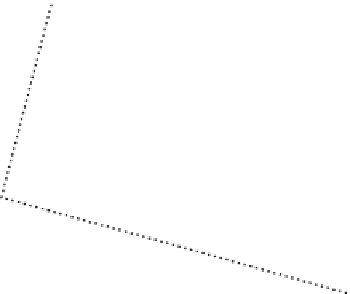Biology Reference
In-Depth Information
FIGURE 6.14
Interpretation of CV scores in
terms of the original axes. (A) Rescaling the axes
has been reversed, restoring orthogonality of
X
1
and
X
2
. White circles represent the scores of one
individual on each CV. (B) Rotation of the original
axes is reversed, restoring the original orientation.
Arrows show projections of the CV scores onto the
original axes; each CV score represents a combina-
tion of scores on the original axes.
X
2
CV2
CV1
X
1
(A)
PC1
CV1
CV2
(B)
X
1
them can be summarized as a plane defined by two vectors, whether the original data
included three variables or 300.
Algebraic Description
In CVA, as in PCA, we begin with a set of measures or coordinates
X
5
(
X
1
,
X
2
,
X
3
...
X
P
), and we want to find the vector
A
1
5
(
A
11
,
A
21
,
A
31
...
.A
P
1
) such that:
Y
1
5
A
11
X
1
1
A
21
X
2
1
A
31
X
3
1?1
A
P
1
X
P
(6.37)
In PCA, we solved for the eigenvalues and eigenvectors of the variance
covariance
matrix
S
. In CVA, we are concerned with the ratio of two variance
covariance matrices:
one is the pooled within-groups variance
covariance matrix,
S
W
, which represents the
deviations of individuals from their respective group means; the other is the between-
groups variance
covariance matrix,
S
B
, which represents the portion of the total variance
(deviations from the grand mean) not explained by
S
W
. In other words,
S
W
represents dif-
ferences within groups, and
S
B
represents differences between the groups. So, in CVA we























